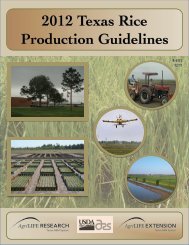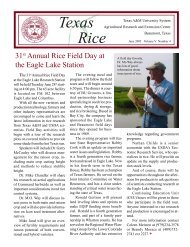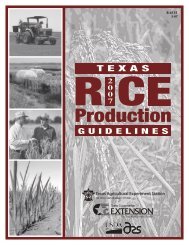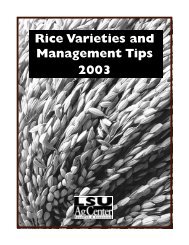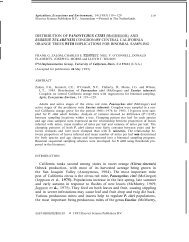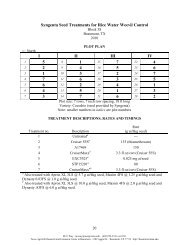Evaluating Potential Rice Varieties from University and Industry ...
Evaluating Potential Rice Varieties from University and Industry ...
Evaluating Potential Rice Varieties from University and Industry ...
Create successful ePaper yourself
Turn your PDF publications into a flip-book with our unique Google optimized e-Paper software.
Table of Contents<br />
EXECUTIVE SUMMARY ........................................................... 5<br />
RESEARCH PRESENTATION ..................................................... 10<br />
I. OBJECTIVE ONE<br />
Measure each variety’s main <strong>and</strong> ratoon crop yield response to two plant populations <strong>and</strong> two nitrogen<br />
rates on clay <strong>and</strong> s<strong>and</strong>y soils.<br />
A. Methods ................................................................ 10<br />
B. Results ................................................................. 11<br />
1. Variety effects on seed/lb, seeding rates <strong>and</strong> seedlings/ft 2 ....................... 11<br />
a. Table 1-A. Seed/pound (i.e., seed size) influence the number of seed/ft 2 at various<br />
seeding rates. ...................................................... 23<br />
b. Table 1-B. Variety <strong>and</strong> seeding rate effects on seedling achieved population <strong>and</strong> %<br />
seedlings emerged at two locations in 2003. .............................. 24<br />
2. Variety effects on main <strong>and</strong> ratoon crop yield ................................. 12<br />
3. Plant population <strong>and</strong> N effects on main crop <strong>and</strong> ratoon crop yield ................ 13<br />
a. Figures 3-A, 3-B, 3-C <strong>and</strong> 4-A,4-B, <strong>and</strong> 4-C. Showing main <strong>and</strong> ratoon crop yield, <strong>and</strong><br />
response to N <strong>and</strong> seedlings/ft 2 ......................................33-38<br />
4. Variety effects on grain milling ............................................ 14<br />
II.<br />
OBJECTIVE TWO<br />
Identify varieties with best yield <strong>and</strong> milling when planted beyond the optimum date.<br />
A. Methods ................................................................ 15<br />
B. Results ...............................................................15-16<br />
1. Table 2-A. Delayed planting effect on main crop yield of 9 conventional varieties, 2 herbicide<br />
resistant varieties <strong>and</strong> 4 hybrids at Beaumont during 2003. ...................... 25<br />
2. Table 2-B. Delayed effect on main crop yield of 7 conventional, 2 herbicide resistant varieties<br />
<strong>and</strong> 4 hybrids at Eagle Lake in 2003 ........................................ 26<br />
3. Table 3. Milling yields as influenced by variety, location, early planting (Objective One) <strong>and</strong><br />
delayed planting (Objective Two) during 2003. ................................ 27<br />
2



